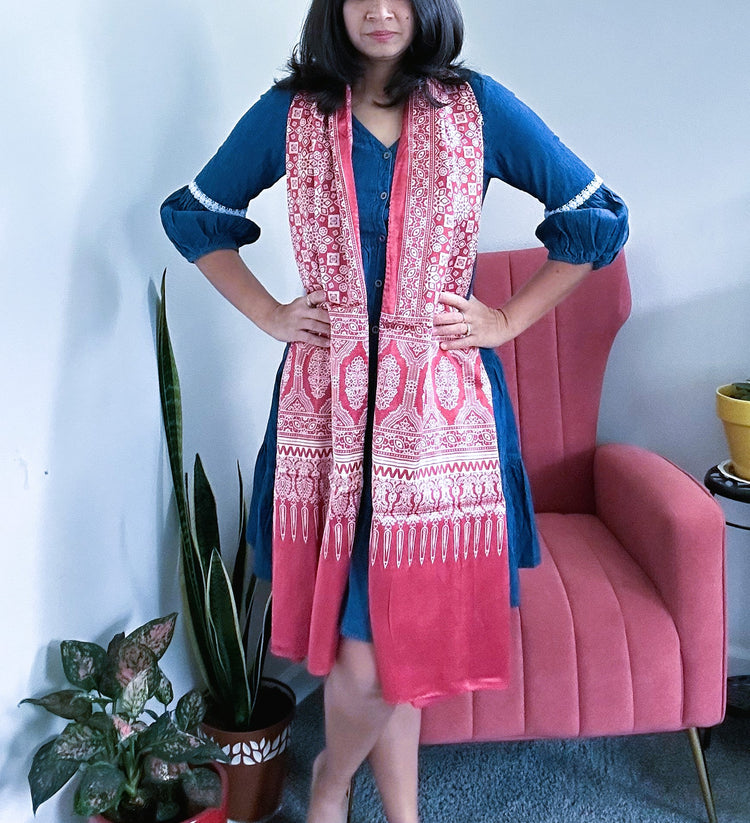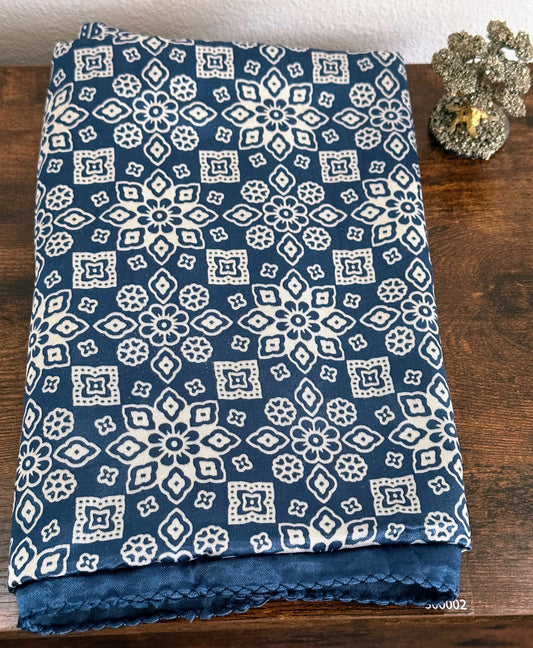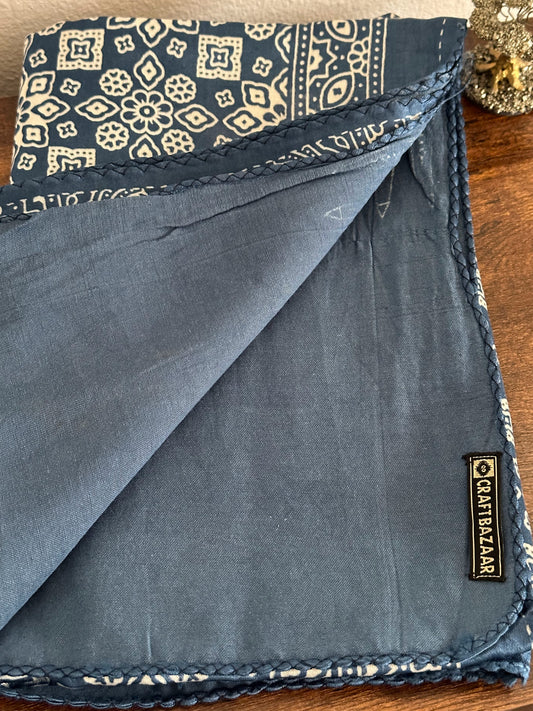-
Mashru Silk Ajrakh Stole & scarves for women [Blue]
Regular price $58.00 AUDRegular priceUnit price per$70.00 AUDSale price $58.00 AUDSale
Discover more of our favorites
Example product title
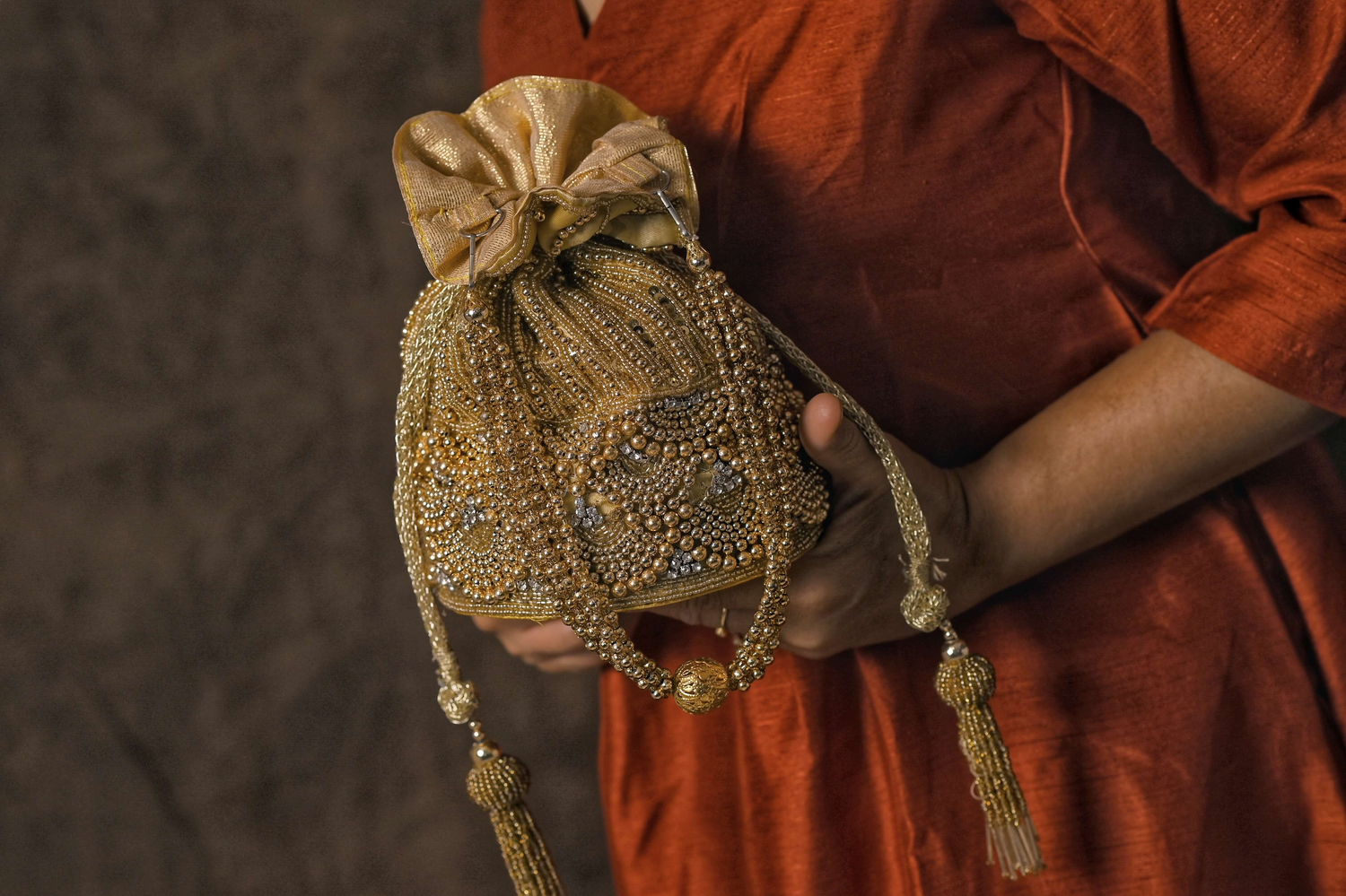
Potli Bags
Potli bags (Drawstring Bag/ Bundle Bag) are irreplaceable fashion accessories that women...
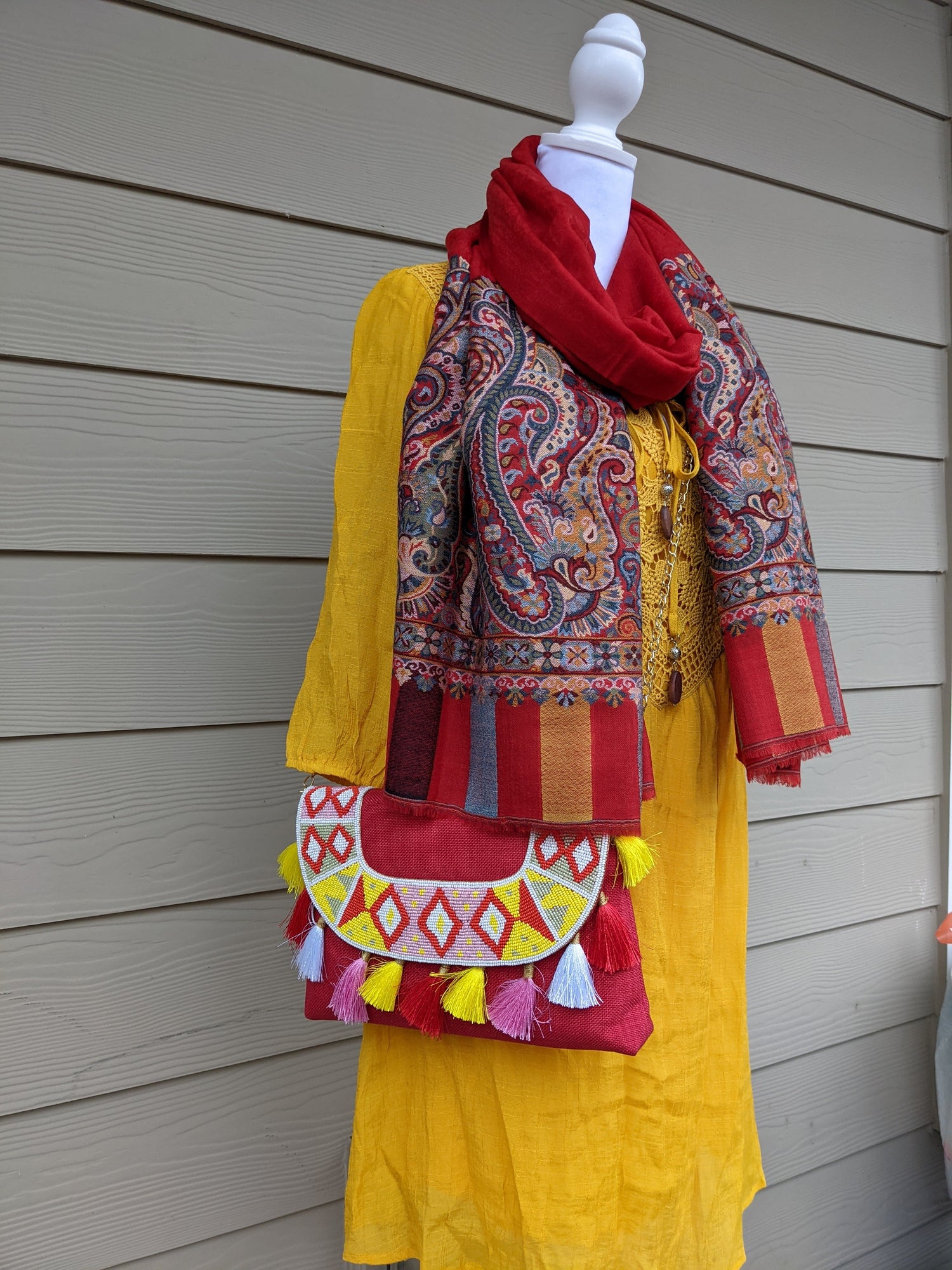
We got you covered for every occasion and all seasons!
At Craft Bazaar our goal is to provide unique and good quality accessories from different parts of India. And to support the local craftsmen who are working very hard to preserve those artforms.
Ajrakh Silk Scarves
A Touch of Timeless India: The Allure of Ajrakh Silk Scarves
The world of textiles is a tapestry woven with vibrant cultures and age-old traditions. In India, one thread that stands out for its exquisite beauty and rich history is Ajrakh. This art of hand-block printing isn't just a craft; it's a conversation between the artisan and the fabric, leaving behind a symphony of colors and intricate patterns. And when this ancient art form adorns the luxurious canvas of silk, the result is an Ajrakh silk scarf - a timeless treasure that elevates any outfit and whispers stories of heritage.
A Legacy Etched in Natural Dyes
The origin of Ajrakh is believed to date back to Sindh (now part of Pakistan) and Gujarat in India. Its name itself hints at its roots, with some tracing it back to the Sanskrit word 'Ajjrakh' meaning resist-dyed cloth, while others link it to the Arabic word 'Azrak' meaning blue. This connection to both languages reflects the cultural confluence that shaped this art form.
The magic of Ajrakh lies in its natural dyes and the resist-dyeing technique. Indigo, extracted from the indigo plant, paints the fabric a deep, mesmerizing blue. Madder root imparts a fiery red, while other natural dyes like pomegranate rinds and heartwood trees lend earthy tones of brown and black. The intricate geometric and floral patterns are meticulously carved onto wooden blocks, which are then dipped in dye and pressed onto the fabric. Each imprint tells a story - paisleys symbolizing fertility, mango motifs representing prosperity, and kalpais (boteh) signifying a teardrop, a reminder of life's impermanence.
The resist-dyeing process is an art in itself. Using a resist paste made from natural materials like gum and clay, artisans meticulously block off specific areas of the fabric, preventing them from absorbing the dye. This meticulous layering creates the stunning, often two-toned, designs that are characteristic of Ajrakh.
Beyond Adornment: A Celebration of Craftsmanship
Owning an Ajrakh silk scarf is more than just having a beautiful accessory. It's a conscious choice to support a centuries-old art form and the skilled artisans who keep it alive. Each scarf is a testament to their dedication, patience, and artistry. The slight irregularities in the patterns are not imperfections, but rather signatures of human touch, making each scarf a one-of-a-kind masterpiece.
A Versatile Jewel for Every Ensemble
The beauty of Ajrakh silk scarves lies in their versatility. The luxurious drape of silk and the captivating patterns make them perfect for elevating any outfit. Here are just a few ways to incorporate them into your style:
- Classic Elegance: Drape a rectangular scarf around your neck for a timeless touch. Opt for contrasting colors or a more subtle monochromatic look depending on the occasion.
- Modern Twist: Tie a square scarf into a stylish headscarf, channeling your inner Audrey Hepburn.
- A Touch of Boho Chic: Wrap a larger scarf around your waist as a statement belt, adding a pop of color and pattern to a simple dress.
- Effortless Glamour: Fold a scarf into a triangle and tie it over a summer dress for a touch of effortless elegance.
- Accessorize with Flair: Don't limit yourself to clothing! Tie a scarf around your handbag or hat for a unique and personalized touch.
Caring for Your Heirloom
Ajrakh silk scarves, like any work of art, require proper care to ensure their longevity. Here are some tips:
- Gentle Hand Wash: Hand-wash your scarf in cold water with a mild detergent. Avoid harsh chemicals and wringing.
- Air Dry is Best: Let your scarf air dry flat in the shade, away from direct sunlight.
- Iron with Caution: If ironing is necessary, use a low heat setting and place a thin cloth between the iron and the scarf.
- Store with Love: Store your scarf in a cool, dry place, away from direct sunlight and moisture.
An Investment in Sustainable Luxury
In a world of fast fashion, Ajrakh silk scarves offer a sustainable alternative. Made with natural dyes and traditional techniques, they have a lower environmental footprint than synthetically dyed fabrics. By choosing Ajrakh, you're not just getting a beautiful piece, you're supporting sustainable practices and preserving a precious cultural heritage.
Owning a Piece of India
An Ajrakh silk scarf is more than just a fashion statement; it's a conversation starter. It's a chance to share the rich cultural heritage of India and the artistry of its people. So, drape yourself in a piece of timeless beauty, embrace the colors and stories woven into each thread, and let the world be touched by the magic of Ajrahk.
Frequently Asked Questions (FAQ) About Ajrakh Silk Scarves:
Q. What is Ajrakh silk scarf?
A. Ajrakh is a resist-dyed textile craft practiced in Sindh, Pakistan, and Gujarat, India. Ajrakh silk scarves are made using this resist-dyeing technique on a silk fabric. These scarves are known for their intricate geometric patterns and vibrant colors.
Q. How is Ajrakh silk scarf made?
A. The process of making an Ajrakh silk scarf is elaborate and involves several steps. First, the silk fabric is washed and scoured to remove any impurities. Then, the fabric is dyed using natural dyes such as indigo and madder. The resist paste, made from gum and clay, is then applied to the fabric to create the desired patterns. The fabric is then dyed again, and the resist paste is washed away to reveal the final design.
Q. What are the different types of Ajrakh silk scarves?
A. There are two main types of Ajrakh silk scarves: dabi and khatia. Dabi scarves are made using indigo dye, while khatia scarves are made using madder dye. Ajrakh silk scarves can also be classified by their designs. Some common designs include geometric patterns, floral patterns, and paisley patterns.
Q. What are the benefits of wearing an Ajrakh silk scarf?
A. Ajrakh silk scarves are not only beautiful but also comfortable to wear. Silk is a natural fiber that is soft, breathable, and hypoallergenic. Ajrakh silk scarves can be dressed up or down and can add a touch of elegance to any outfit.
Q. How to care for an Ajrakh silk scarf?
A. Ajrakh silk scarves are delicate and should be cared for properly. It is recommended to hand-wash your scarf in cold water with a mild detergent. Do not wring or twist the scarf, and lay it flat to dry. Avoid ironing your scarf, or if you must, iron it on the lowest setting.
Q. What is the price of an Ajrakh silk scarf?
A. The price of an Ajrakh silk scarf can vary depending on the size, quality, and complexity of the design. However, you can expect to pay anywhere from Rs. 500 to Rs. 5,0 for a good quality scarf.
Q. Where can I buy an Ajrakh silk scarf?
A. Ajrakh silk scarves can be purchased from online retailers or from handicraft stores in India and Pakistan. When buying an Ajrakh silk scarf, it is important to choose a reputable seller to ensure that you are getting a genuine product.
Q. How can I tell if an Ajrakh silk scarf is real?
A. A real Ajrakh silk scarf will be made using natural dyes and will have a unique, hand-made look. The colors should be rich and vibrant, and the patterns should be intricate. You can also check for the presence of the Ajrakh stamp, which is often used by artisans to identify their work.
Q. What are some of the things to consider when buying an Ajrakh silk scarf?
A. When buying an Ajrakh silk scarf, consider the size, color, and design of the scarf. You should also consider the price and the quality of the fabric. It is important to find a scarf that you love and that will complement your wardrobe.
Q. Can Ajrakh silk scarves be worn by men?
A. Yes, Ajrakh silk scarves can be worn by both men and women. Men can wear Ajrakh silk scarves as neck scarves or as head scarves. Ajrakh silk scarves can add a touch of style and sophistication .
